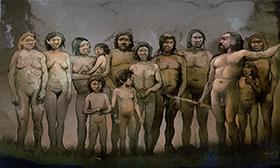The Y-chromosome study reveals ancient Neanderthal-Homo Sapiens hybrids
A study involving the University of Oviedo and the CSIC (Spanish National Research Council) shows that Neanderthals had greater genetic similarity to Homo sapiens than to Denisovans. Of the three Neanderthal samples analysed, one comes from the Asturian El Sidrón site, thus confirming its international relevance
An international team, including research staff from the University of Oviedo and the Spanish National Research Council (CSIC), and published in Science journal, has analysed the genetic sequences of the Y-chromosome (the male sex chromosome) extracted from three Neanderthal and two Denisovan fossils - the latter being a kind of early human that lived in Siberia, closely related in evolutionary terms to the Neanderthals. However, study of the Y chromosome reveals a greater genetic similarity between Neanderthals and modern man, Homo sapiens, which leaves Denisovans as a lineage from an older root for this genetic marker.
The University of Oviedo's involvement was provided by Professor Marco de la Rasilla, director of excavations at the Asturian El Sidrón site. He says, "Research at El Sidrón continues to yield important results that allow us better to understand Neanderthal groups. There is no doubt that the site is a point of reference that places Piloña and Asturias in the scientific and cultural scene nationally and internationally".
Fossil DNA analysis has changed our understanding of human evolutionary history. The existence of genetic flows between different human species, including those between Neanderthals and modern humans, has been found to be a key factor in the study of the human evolutionary tree.
"About 100,000 years ago, there were several different species of humans, including modern humans, Neanderthals and Denisovans," explains Antonio Rosas, a researcher at MNCN-CSIC, the National Museum of Natural Sciences. "The study into the genome confirmed that Neanderthals were the human sister group of our present human species (H. sapiens)," he adds.
In turn, the discovery of a new DNA variant in the remains of the Denisova cave in Siberia revealed the existence of a new human type, closely related evolutionarily to the Neanderthals, with whom they shared their last ancestor some 350 billion years ago.
However, analysis of the mitochondrial DNA of the fossils from archaeological site Sima de los Huesos at Atapuerca - which are approximately 400,000 years old and are the direct ancestors of the Neanderthals - revealed something that did not fit into the scheme. "The mitochondrial DNA that was found - a small circular chromosome found in a cell organelle called the mitochondrion - more closely resembles that of Denisovans than of Neanderthals, despite the fact that Neanderthals and Denisovans share an ancestor who lived long after the Sapiens and Neanderthal lineages separated," the CSIC researcher said.
This model has been confirmed by the recent study of the Y chromosome, in which research staff analysed the genetic sequences of two Denisovan and three Neanderthal hominids, one of them from the El Sidrón site. "As with mitochondrial DNA, the Y chromosome reveals a greater similarity between Neanderthals and Homo sapiens - indicating that the two are genetically very close, while the Denisovan Y chromosome appears to have an older root," adds Rosas.
Scientists have suggested that the greater similarity of the Homo sapiens and Neanderthals DNA, compared to that of Denisovans, could be due to a hybrid having developed between the two. The model suggests that there was an encounter between the two species about 300,000 years ago, when some hominids related to the Homo sapiens lineage transferred certain genes to the Neanderthals at an earlier stage of their evolution. In other words, "the earliest Neanderthals must have originally carried mitochondrial DNA similar to that of the Denisovans and which was later replaced through gene flow from a lineage related to Homo sapiens".
This replacement of genetic lineages during the Neanderthals' evolution may be due to the effects of chance within small, isolated populations - something that is confirmed by the observation of small genetically based skeletal abnormalities, likely due to inbreeding or cross-breeding between close relatives. "It is in a context of groups with few individuals, dispersed around the territory, that the purifying selection is much more smoothed out, and where the process of replacement of mitochondrial DNA and Y chromosome can be understood," adds Rosas.
The analysis of paternal lineages is one of the few unknowns about the Neanderthals to remain unresolved - "partly because most of the well-preserved samples were women," explains Carles Lalueza Fox, researcher at IBE (Institute of Evolutionary Biology) - a joint venture between CSIC and Pompeu Fabra University. "With this study, not only have we discovered a new migration from Africa to Europe some 300,000 years ago, but we can also make a prediction: the Y chromosomes prior to this date will be more similar to those of Denisovans than those of Neanderthals themselves," concludes Lalueza Fox.
Martin Petr, Mateja Hajdinjak, Qiaomei Fu, Elena Essel, Hélène Rougier, Isabelle Crevecoeur, Patrick Semal, Liubov V. Golovanova, Vladimir B. Doronichev, Carles Lalueza-Fox1, Marco de la Rasilla, Antonio Rosas, Michael V. Shunkov, Maxim B. Kozlikin, Anatoli P. Derevianko, Benjamin Vernot, Matthias Meyer, Janet Kelso. "The evolutionary history of Neanderthal and Denisovan Y chromosomes." Science.
Images gallery




